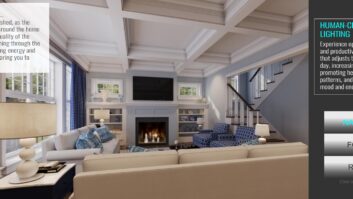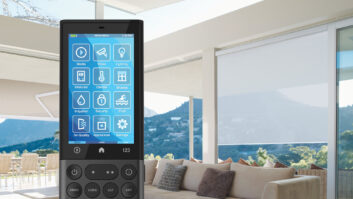In todays increasingly competitive marketplace, manufacturers from all industries are turning to professional industrial design to enhance their products and help them stand out from the pack. They know that superior design can make a product look more expensive, offer unique features and solutions and support the companys overall brand image. In short, it is good for business and the bottom line.
In fact, product design is no longer exclusive to luxury brands or elite boutiques. Suppliers with price-driven products in competitive markets are learning that differentiation and increased perceived value are the difference between getting shelf space and/or making a profit. In turn, this approach simply raises the bar for high-end specialty products to justify their market position, with even better design.
Nowhere is this more applicable than in specialty consumer electronics and custom installation. Excellent product design can make visible products look stylish and expensive or blend into dcor. Or they can make them less obtrusive bordering on invisible.
For custom installers, industrial design can mean products that are easier and faster to install. For their customers, it can even provide products that are easier and simpler to use which can translate into higher satisfaction with fewer callbacks.
For the fourth year in a row, Residential Systems celebrates excellence in industrial design with the Resi Awards. Manufacturers from all product categories submit their designs for consideration and explain what the unique, compelling benefits are. Finalists are featured in the sidebar within this article, with the winners announced at a special awards ceremony at CEDIA EXPO in Denver.
With the Resi Awards just around the corner, featured here are several innovative companies that have embraced industrial design in a big way. Company presidents, CEOs, and senior managers were asked about their commitment to industrial design and how it has benefited their brands as well as their customers.
Russound, Newmarket, NH
Maureen Baldwin, CEO
Russound, a leading multi-room audio brand, makes everything from volume controls and speakers to state-of-the-art control systems and media servers. Celebrating its 40th anniversary in 2007, the company in recent years has dramatically upgraded its styling and industrial design especially in user interfaces.
Design resource: Numerous firms including Cambridge Product Design of England as well as Catalano Design of Boston
Importance of industrial design: A while back, we simply decided we wanted to improve the way our products looked and felt, Baldwin said. Since the keypad is what customers see the most, and is what operates the system, they have to be attractive and easy to use. So our first landmark design was with the distinctive A-BUS keypad and that was quickly followed by the UNO-S2 with scrolling display and backlit screen. Those products were hugely successful and won numerous awards and really got us started on a major product design program.
What was the impact on your company? Commercially, our sales have increased ten-fold and profitability has improved as well, Baldwin noted. For our engineers, designers like Allen Boothroyd give them much-needed design resources and most of all they get to see their efforts result in more successful products. For the entire team at Russound, our products keep everyone jazzed. Everyone here feels that Russound has set a standard for design in the industry and that alone is great for morale.
Guiding philosophy: A simple criteria I have used is whether or not I would put a product in my own home, Baldwin concluded. This has always been a helpful screen that has either kept some products from happening or taken acceptable products and made them exceptional.
Savant, Osterville, MA
Jim Carroll, President
A relative newcomer in a competitive category, Savant was founded in 2005 and offers innovative home control systems for the residential installation market. The complete Savant product suite has been given the moniker Rosie, which provides multi-room audio/video, digital media server, and jukebox capabilities, security surveillance, home automation, and control, all within one integrated solution. With styling and ease of use paramount, industrial design was an important consideration for the New England start-up.
Design resource: Ashcraft Design, Los Angeles, CA
Importance of industrial design: There is a natural expectation from consumers and the industry for a high-end product to appear first-rate, Carroll said. Savant wanted to go above and beyond those expectations; we strived for and are still striving to produce the best-looking products in the industry. In order to achieve these lofty goals, we felt it was imperative to bring in an outside resource to assist an already top quality internal engineering team.
What was the impact on your company? Savant has received rave reviews from the dealer community, our beta participants, potential end consumers, and the press, Carroll noted. We have hosted a number of Dealer Conferences and, of course, exhibited at trade shows. In every instance, the audience has applauded the industrial design and look and feel of our Rosie product line. Savant believes strongly that we have already created a brand image within the industry so early in the game; this has subsequently produced a company enthusiasm and eagerness to deliver the next-generation control and automation technology to the industry.
Guiding philosophy: Our ultimate goal, Carroll concluded, is to get consumers to show off our products in their home and not keep them hidden away!
JBL, Northridge, CA
Paul Bente, President, Harman Consumer Group
One of the oldest and best-known brands in consumer electronics, JBL is well regarded for high-performance loudspeakers in a number product categories and markets. Its roots in hi-fi date back to the 1950s and JBL has been a mainstay in audio and custom installation ever since. Today, as part of the venerable Harman Consumer Group, JBL provides speakers at a wide range of price points, applications, and performance levels.
Design resource: Numerous firms, including Ashcraft Design
Importance of industrial design: JBL started in 1957 with the Paragon loudspeakerthe first JBL product that was created in partnership with an industrial designer, Bente said. Arnold Wolf, who later became president of JBL, did the ID and Richard Ranger was the speakers engineer. As JBLs presence in the home marketplace continued to grow, it became essential that the design of our products integrate into and complement the home environment aesthetically as well as functionally.
What was the impact on your company? Any time you introduce a new product and receive positive feedback, it helps morale and builds enthusiasm, Bente said. It validates the work of the entire development team. If our products deliver superior performance, cutting-edge design and are offered by dealers who can demonstrate both, sales will follow.
Guiding philosophy: The industrial design is what the customer sees first, Bente concluded. Before we get a chance to demonstrate superior performance, they must be attracted to the product. If they like the design, they will listen. If they dont, in many cases performance no longer matters.
Jamo, Denmark
Steen Michaelsen, Director of Marketing
Denmark is world-renowned for its innovative and timeless designs. Since 1968, one of the most consistently interesting audio brands to come out of Denmark is Jamo. In February 2005, Klipsch (another pretty well known brand in its own right) acquired Jamo. The Indianapolis-based parent company is now responsible for marketing and distribution of Jamo products. Jamo offers a wide range of loudspeakers, control systems, and accessories for the residential systems market.
Design resource: Numerous firms over several decades. Jamo often selects designers to each specific task, as each designer has his or her specific strength or weaknesses.
Importance of industrial design: Our business is loudspeakers, and loudspeakers are more than anything else an integral part of the home dcor, Michaelsen said. The decision for which loudspeakers to buy is most of all made using the eyes, and the sound quality is something that is evaluated at a later stage.
What was the impact on your company? Good industrial design helps to get your product displayed in shops or magazines or places where people need something existing to look at, Michaelsen noted. Good-looking products will further be recognized and talked about, which is boosting the enthusiasm not only in the sales force, but in the company in general. Everybody likes to be associated with something outstanding. There is no doubt that industrial design has had an impact on our bottom line. In fact, one could ask the question if Jamo would exist at all today without a serious approach to industrial design!
Guiding philosophy: People want to experience good sound in their homes, but are usually not prepared to sacrifice the interiors of their living room, Michaelsen concluded.
Sonance, Dana Point, CA
Scott Struthers, Co-Founder
Sonance was among the first companies to manufacturer in-wall loudspeakers and considered a pioneer in what is commonly described as Architectural Audio. Industrial design is a hallmark of Sonance products and founder Scott Struthers is as passionate about it as anyone in the industry.
Design resource: Numerous internal and external resources
Importance of industrial design: Design is the original reason Sonance exists, Struthers said. While working as custom installers, we created the first in-wall speaker as a design solution. A Sonance speaker is and was an alternative to box speakers that clash with the prevailing interior design. It was our involvement with interior designers and architects that led to this solution and the coining of the trademarked phrase Architectural Audio. Our internal team that manages branding also provides strategic direction on industrial design so they both move hand-in-hand. We recently launched a new corporate identity and we believe it is a great fit with our industrial design direction. Both support our focus on being the innovator in providing a full range of aesthetically enhanced speaker solutions.
What was the impact on your company? Our company is excited because our people get it, Struthers noted. And they see that interior designers and architects are coming to us because Sonance gets it. This makes us special and our people know it and are proud of it. For sales, we now are seeing more and more high-end specification business because of the unique range of design solutions we offer architects, interior designers and the custom integrators they work with. Design sets us apart. The bottom line is that design provides an additional way for our dealers to sell their clients better and more expensive products. This differentiates themselves from their competitors. That translates to more sales and profit for our dealers and Sonance.
Guiding philosophy: We dont see a separation between our brand image and our industrial design direction, Struthers concluded. It is that important to us.
Peter Hoagland is an industry marketing consultant based in Warrenton, Virginia.















